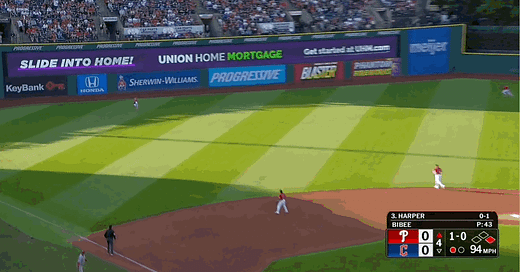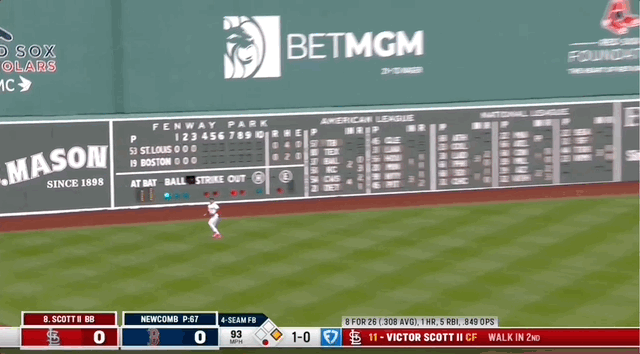The outfield deke is not a play you’re going to see in every game, but it’s perhaps a play you’re seeing more of for good reason. Zach here, and a deke is really just an act of deception, almost always pulled on the baserunner or baserunners who visually track the outfielders to judge what’s happening with the ball in play.
Objective: to make a runner act against his best interests, either staying still when he should be running or charging ahead when he should be retreating. The best ones can bamboozle runners into a double play or shift the balance of pressure in an inning by stopping a would-be advance.
Watch this one. Red Sox left fielder Jarren Duran is fielding a definite hit from Cardinals speedster Victor Scott II. He knows it’s a hit, but the less Fenway-experienced runner on first, Jordan Walker, is not so sure. Duran makes it look like he’s got it lined up to catch, Walker approaches it as if he might need to go back to first. He barely makes it to second, but more importantly, he is now a heavy-footed roadblock at second with Scott at first. If he judges it correctly, that’s a first-and-third situation with Scott very likely to make it a second-and-third situation via steal.
And while this is still a niche tool more than a game-changing edge, it’s becoming more important in the way these things do with the major-league level’s razor-thin margins. There are two big strategic reasons outfielders might want to take some acting classes.
More balls in play are in the air. Not a secret here but more hitters are focused on hitting fly balls and line drives, so there’s more opportunity for outfielders to affect the game. Per Statcast, 46% of all balls in play were fly balls or line drives when tracking began back in 2015. Last season was the first time that number eclipsed 50%, and it’s over 50% this year, too.
More aggressive baserunning. The baserunning rules that accompanied the pitch clock and led to the stolen base spike generally encourage more runners to get moving. MLB as a whole is taking the extra base — going first-to-third on a single, scoring from first on a double — on 42% of opportunities this year, up from 40% the year before the rules changed and 39% in 2015. It’s small, but it’s also team dependent. The Detroit Tigers, for instance, are taking the extra base on 55% of opportunities.
Any move that might keep a run off the board will be considered. This is just a particularly fun one. Steven Kwan, the Guardians star who patrols left field, has clearly become adept at the deke.
Hannah weighing in now: Watch those three examples of dekes and tell me Kwan isn’t the most committed to the bit. I feel like sometimes the deke is more of just a gesture that’s intended to momentarily confuse the runner — which it is! And that’s good! — but Kwan puts on a particularly compelling performance. He’s not trying to just muddle the timing, but rather actively convince the runner he’s about to catch a ball that he knows will be bouncing off the wall for a hit. Here’s the Phillies broadcast for the above the play, they’re fully fooled.) That’s not the only time this season he’s successfully pulled it off, either!
It’s just part of an overall defensive ability that’s garnered three Gold Gloves in Kwan’s first three seasons. It’s definitely a specific skill, but one that’s hard to imagine training. I wanted to understand how a player gets particularly good at the believable outfield deke and so last week, I talked to Guardians outfield and baserunning coach (dekes make a compelling case for why those two facets of the game are linked) J.T. Maguire, who has coached Kwan for close to a decade in the Cleveland organization.
Hannah: Outfield dekes: Do you plan them?
Maguire: I mean, we definitely talk about them, but it's so sporadic, it's so randomized. I think what works, though — like, Kwany for example, he always takes live reads during batting practice. He is always working on that ball that's over his head where he knows that he's not going to be able to catch it. We're fortunate that we have a really high wall at home, but even on a wall like this [at Yankee Stadium], he can understand where that ball is uncatchable, and then he times up with the speed of the runner or the knowledge of the runner. So he does a really good job of understanding who the runners are on bases we can do it against, and who we can't do it against.
That feels like he must have to have so much information in his head. Because you’re reacting off the bat like maybe I can catch this and then to have to process that information in real time. Is he the best you’ve seen at it?
I think so. So, it’s funny, Myles Straw is one that actually kind of pushed him towards doing that. Myles Straw is actually really good at doing it. I asked Myles my first year, I said, “Hey, do you mind sharing this information? You're one of the best at doing it.” And he took to Kwany and they have a really good relationship. But, yeah, he probably started it for Kwan. And now you can see, like a couple of our guys, [Jhonkensy] Noel does it a little bit. Angel Martínez will do it a little bit because of what Myles Straw taught.
Is there acting involved? You have to really commit, right?
Keep reading with a 7-day free trial
Subscribe to The Bandwagon to keep reading this post and get 7 days of free access to the full post archives.








